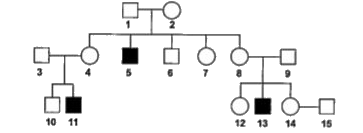Identify the correct statement:
0.1MNaCl and 0.1M glucose solution are isotonic
0.1MNaCl and 0.3M glucose solution are isotonic
The boiling point of 0.1m aqueous urea solution is less the 0.1m aqueous KCl solution
The freezing point of 0.1m glucose solution is less than 0.1mKCl solution.
The correct Answer is:C
To solve the question of identifying the correct statement regarding isotonic solutions and their properties, we will analyze each option step by step.
1. Understanding Isotonic Solutions:
- Isotonic solutions have the same osmotic pressure, which depends on the concentration of solute particles in the solution. The van't Hoff factor (i) is crucial in determining this.
2. Analyzing Option A:
- Statement: 0.1 molar NaCl and 0.1 molar glucose solution are isotonic.
- Van't Hoff Factor:
- NaCl dissociates into 2 ions (Na⁺ and Cl⁻), so i=2.
- Glucose does not dissociate, so i=1.
- Effective Concentration:
- For NaCl: 0.1mol/L×2=0.2
- For glucose: 0.1mol/L×1=0.1
- Since the effective concentrations are different, they are not isotonic.
3. Analyzing Option B:
- Statement: 0.1 molar NaCl and 0.3 molar glucose solution are isotonic.
- Van't Hoff Factor:
- NaCl: i=2 (as calculated before).
- For glucose at 0.3 molar: 0.3mol/L×1=0.3.
- Effective Concentration:
- For NaCl: 0.1mol/L×2=0.2
- For glucose: 0.3mol/L×1=0.3
- Since the effective concentrations are different, they are not isotonic.
4. Analyzing Option C:
- Statement: The boiling point of 0.1 molal aqueous urea solution is less than that of 0.1 molal aqueous KCl.
- Van't Hoff Factor:
- Urea: i=1
- KCl: i=2
- Boiling Point Elevation:
- The boiling point elevation is proportional to the van't Hoff factor and concentration.
- Since KCl has a higher van't Hoff factor, the boiling point of KCl will be higher than that of urea.
- Therefore, this statement is true.
5. Analyzing Option D:
- Statement: The freezing point of 0.1 molar glucose solution is less than that of 0.1 molar KCl.
- Van't Hoff Factor:
- Glucose: i=1
- KCl: i=2
- Freezing Point Depression:
- The freezing point depression is also proportional to the van't Hoff factor and concentration.
- Since KCl has a higher van't Hoff factor, the freezing point of KCl will be lower than that of glucose.
- Therefore, this statement is true.
Conclusion:
Both options C and D are correct statements.
Final Answer:
The correct statements are Option C and Option D.
---
- Isotonic solutions have the same osmotic pressure, which depends on the concentration of solute particles in the solution. The van't Hoff factor (i) is crucial in determining this.
- Statement: 0.1 molar NaCl and 0.1 molar glucose solution are isotonic.
- Van't Hoff Factor:
- NaCl dissociates into 2 ions (Na⁺ and Cl⁻), so i=2.
- Glucose does not dissociate, so i=1.
- Effective Concentration:
- For NaCl: 0.1mol/L×2=0.2
- For glucose: 0.1mol/L×1=0.1
- Since the effective concentrations are different, they are not isotonic.
- Statement: 0.1 molar NaCl and 0.3 molar glucose solution are isotonic.
- Van't Hoff Factor:
- NaCl: i=2 (as calculated before).
- For glucose at 0.3 molar: 0.3mol/L×1=0.3.
- Effective Concentration:
- For NaCl: 0.1mol/L×2=0.2
- For glucose: 0.3mol/L×1=0.3
- Since the effective concentrations are different, they are not isotonic.
- Statement: The boiling point of 0.1 molal aqueous urea solution is less than that of 0.1 molal aqueous KCl.
- Van't Hoff Factor:
- Urea: i=1
- KCl: i=2
- Boiling Point Elevation:
- The boiling point elevation is proportional to the van't Hoff factor and concentration.
- Since KCl has a higher van't Hoff factor, the boiling point of KCl will be higher than that of urea.
- Therefore, this statement is true.
- Statement: The freezing point of 0.1 molar glucose solution is less than that of 0.1 molar KCl.
- Van't Hoff Factor:
- Glucose: i=1
- KCl: i=2
- Freezing Point Depression:
- The freezing point depression is also proportional to the van't Hoff factor and concentration.
- Since KCl has a higher van't Hoff factor, the freezing point of KCl will be lower than that of glucose.
- Therefore, this statement is true.
Both options C and D are correct statements.
The correct statements are Option C and Option D.
Similar Questions
Knowledge Check
- Question 1 - Select One
The pedigree chart given below represents the pattern of inheritance of haemophilia in a family. Study it carefully and answer the following questions:

Identify the correct statement with respect to member '4':AHe is a carrier maleBShe is a carrier femaleCHe is haemophilicDShe is a homozygous female - Question 2 - Select One
Consider a Py orbital of an atom and identify correct statement
As-orbital of another atom produces π-bond when y is the bond formation axisBpy-orbital of another atom produces σ-bond when x is the bond formation axis.Cpz-orbital of another atom produces π-bond when x is the bond formation axis.Ddxy-orbital of another atom produces π-bond when x is the bond formation axis


